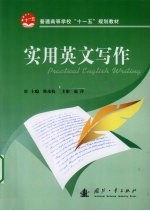图书介绍
实用英文写作2025|PDF|Epub|mobi|kindle电子书版本百度云盘下载

- 韩彦枝编著 著
- 出版社: 北京:国防工业出版社
- ISBN:9787118067941
- 出版时间:2010
- 标注页数:236页
- 文件大小:17MB
- 文件页数:246页
- 主题词:英语-写作-高等学校-教材
PDF下载
下载说明
实用英文写作PDF格式电子书版下载
下载的文件为RAR压缩包。需要使用解压软件进行解压得到PDF格式图书。建议使用BT下载工具Free Download Manager进行下载,简称FDM(免费,没有广告,支持多平台)。本站资源全部打包为BT种子。所以需要使用专业的BT下载软件进行下载。如BitComet qBittorrent uTorrent等BT下载工具。迅雷目前由于本站不是热门资源。不推荐使用!后期资源热门了。安装了迅雷也可以迅雷进行下载!
(文件页数 要大于 标注页数,上中下等多册电子书除外)
注意:本站所有压缩包均有解压码: 点击下载压缩包解压工具
图书目录
Chapter 1 Applying Words Properly1
1.1 Types of words1
1.1.1 Common words,technical words and nonstandard words1
1.1.2 Formal words and colloquial words1
1.1.3 Abstract words and concrete words2
1.1.4 General words and specific words3
1.2 Meanings of words3
1.2.1 Polysemy3
1.2.2 Denotation and connotation3
1.2.3 Context and meaning4
1.3 Synonyms4
1.4 The use of words6
1.4.1 Collocation6
1.4.2 The usage of a word7
1.4.3 Variety in using words7
1.5 Idiom9
1.6 Diction10
1.7 Exercises11
Chapter 2 Writing Correct and Effective Sentences13
2.1 Types of sentences13
2.1.1 Classified according to the elements13
2.1.2 Classified according to function14
2.1.3 Classified according to structure14
2.1.4 Classified according to length15
2.1.5 Classified according to rhetoric16
2.1.6 Exercises17
2.2 Effective sentences18
2.2.1 Unity18
2.2.2 Conciseness19
2.2.3 Clarity21
2.2.4 Coherence22
2.2.5 Variety23
2.2.6 Emphasis within sentences25
2.2.7 Emphatic sentences27
2.2.8 Exercises29
2.3 Sentence skills30
2.3.1 Complete sentences,minor sentences and sentence fragments31
2.3.2 Coherence and incoherence32
2.3.3 Fused sentences or run-on sentences36
2.3.4 Comma splices and comma faults36
2.4 Effective sentence patterns for English writing37
2.5 Exercises46
Chapter 3 Paragraph48
3.1 Isolated paragraph48
3.1.1 Controlling idea48
3.1.2 Support of the controlling idea49
3.2 Five-paragraph writing50
3.2.1 Introductory paragraph51
3.2.2 Topic sentence52
3.2.3 Central paragraph57
3.2.4 Concluding paragraph58
3.2.5 Transitional words and phrases60
3.2.6 Developing paragraph61
3.2.7 Exercises88
Chapter 4 Writing a Whole Essay105
4.1 Steps in writing a whole essay105
4.1.1 Planning105
4.1.2 Drafting108
4.1.3 Revision109
4.1.4 Finalizing110
4.2 Main parts of an essay110
4.2.1 The opening part110
4.2.2 The developing part111
4.2.3 The closing part111
4.3 Types of writing111
4.3.1 Description111
4.3.2 Narration115
4.3.3 Argumentation118
4.3.4 Exposition120
4.4 Exercises134
Chapter 5 Practical Writing135
5.1 Letters135
5.1.1 Introduction135
5.1.2 Format of letters136
5.1.3 Letters of introduction141
5.1.4 Job application letters142
5.1.5 Application for admittance145
5.1.6 Exercises148
5.2 Resume148
5.2.1 Brief introduction148
5.2.2 Content and organization149
5.2.3 Sample writing152
5.2.4 Exercises154
5.3 Brief messages154
5.3.1 Notes154
5.3.2 Greeting cards167
5.3.3 Notices169
5.3.4 Fax messages170
5.3.5 E-mails172
5.3.6 Exercises173
Chapter 6 CET Writing175
6.1 Introduction of CET writing175
6.1.1 Requirements175
6.1.2 Principles of scoring175
6.1.3 Standards of scoring175
6.2 Analysis on types of writing176
6.2.1 Topic sentence composition176
6.2.2 Key words composition177
6.2.3 Outline composition178
6.2.4 Composition based on tables,graphs,charts,etc180
Chapter 7 Writing a Research Paper182
7.1 Steps in writing a research paper182
7.1.1 Choosing a suitable topic182
7.1.2 Collecting useful data for your paper183
7.1.3 Analyzing materials and forming the outline184
7.1.4 Drafting the paper185
7.1.5 Revision and finalizing186
7.2 The format of a research paper187
7.2.1 The structure of a paper187
7.2.2 Using quotations187
7.2.3 The format for adding notes and the final bibliography188
7.3 Exercises192
Chapter 8 Using Rhetoric Appropriately194
8.1 Lexical stylistic devices194
8.1.1 Simile194
8.1.2 Metaphor195
8.1.3 Metonymy195
8.1.4 Synecdoche195
8.1.5 Personification196
8.1.6 Hyperbole196
8.1.7 Understatement197
8.1.8 Transferred epithet197
8.1.9 Euphemism197
8.1.10 Pun198
8.1.11 Irony198
8.1.12 Paradox198
8.1.13 Oxymoron199
8.1.14 Allusion199
8.2 Syntactical stylistic devices200
8.2.1 Repetition200
8.2.2 Climax200
8.2.3 Anticlimax201
8.2.4 Antithesis201
8.2.5 Parallelism202
8.2.6 Rhetorical question203
8.2.7 Inversion203
8.3 Phonetic stylistic devices203
8.3.1 Alliteration203
8.3.2 Assonance204
8.3.3 Consonance204
8.4 Exercises205
Chapter 9 Punctuation and Manuscript Form207
9.1 The functions of ordinary punctuation marks207
9.1.1 Comma(,)207
9.1.2 Period(.)208
9.1.3 Question mark(?)209
9.1.4 Exclamation mark(!)209
9.1.5 Colon(:)209
9.1.6 Semicolon(;)210
9.1.7 Quotation marks(" ")210
9.1.8 Parentheses(())211
9.1.9 Dash(—)212
9.1.10 Ellipsis points(...)212
9.2 Manuscript form212
9.2.1 Pages212
9.2.2 Title212
9.2.3 Indention213
9.2.4 Italics213
9.2.5 Capitalization213
9.3 Exercises214
Appendix216
Answers to exercises219
References236
热门推荐
- 2199602.html
- 2553953.html
- 1980849.html
- 2508883.html
- 485257.html
- 2792423.html
- 3140938.html
- 581560.html
- 1015948.html
- 1820045.html
- http://www.ickdjs.cc/book_1955654.html
- http://www.ickdjs.cc/book_435569.html
- http://www.ickdjs.cc/book_3434358.html
- http://www.ickdjs.cc/book_1263012.html
- http://www.ickdjs.cc/book_1745918.html
- http://www.ickdjs.cc/book_1677.html
- http://www.ickdjs.cc/book_3617831.html
- http://www.ickdjs.cc/book_3337697.html
- http://www.ickdjs.cc/book_509168.html
- http://www.ickdjs.cc/book_1314911.html